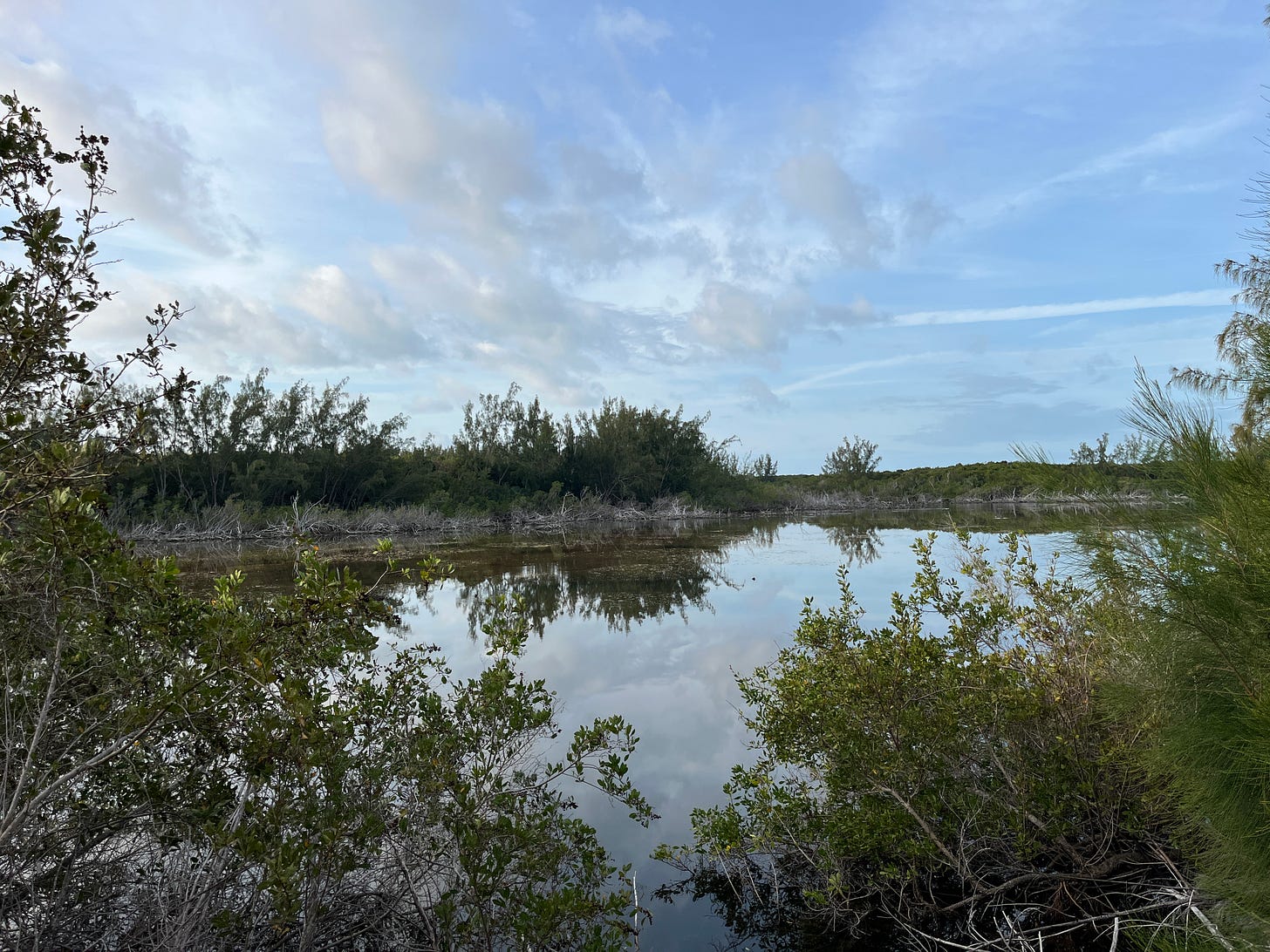Dispatch from a brackish pond
Also, more on the early return of Pippin the Piping Plover—and now Imani.
Recently I was at 25 degrees north latitude, near the Tropic of Cancer, and had a chance to explore a brackish pond—that is, an inland pond usually found near the sea coast that has a touch of salt. The salinity of the water is about 5% that of sea water and well more than fresh water. The depth was no more than 3 feet and usually less than that. Algae mats I soon realized were the source of the pond’s orange coloration. The mats serve an important purpose, preventing leakage of the water downward. Eventually the algae will die if salinity increases. In a rainier season, the pond will fill up more and the status quo will prevail.
I always believed these ponds filled mostly from rain water or possible storm surge. But in doing some research, it is possible they sit below the water table and the ocean seeps under the big ridge that rises between the sea and the pond. The ridge made getting the kayak to the pond…interesting. I asked one of my companions to carry the `yak with me, up a 60-foot bluff, over the ridge, and then back down to the pond. We had to clear away some downed casuarinas to make a little boat ramp.
It was slow going in a kayak, the algae mats nearly impenetrable. I had a closer view of Least Grebes than ever, though. When standing above the pond, the grebes would casually scatter as I approached. Being on the water really freaked them out, though. They would plunge under water amid the roots and knees of the mangroves and hew close to shore. Then they’d pop up 20 or 30 yards down the shore, away from me. Again, there isn’t much water that isn’t bound up in algae and open enough for grebe plunges.
Least Grebes are birds of the Caribbean, Central America, and South America and are the smallest member of the grebe family (about the size of a robin); some nest on the pond, though all on my visit appeared to be immature birds. In March, when the visit took place, there were still wintering ducks in the pond, birds we know from the East and Midwest: American Wigeon, Blue-winged Teal, and Ring-necked Duck to name a few. And there were loads of waders and other swimmers: Little Blue Heron (shown in clip), Tricolored Heron, Black-necked Stilt, White-cheeked Pintail, Common Gallinule, and American Coot.
One could easy overlook a place like this when juxtaposed with so much natural beauty, azure waters, swaying palm trees, and pink sand. But as time’s gone on, I’ve found this spot more and more charming. It’s a salty oasis that the birds seem to enjoy, too.

The return of Pippin (and now Imani)
Pippin is a Green Bay bird who’s quickly becoming a Chicagoan. Packers and Bears fans alike can applaud the Piping Plover’s chutzpah. Pippin arrived back at Montrose Beach on April 11, along with a wingman, Larry. Since then, Larry has moved on, likely to points north in Michigan.
Pippin arrived earlier to Chicago than any Piping Plover I could recall. So I checked this thought with Geoff Williamson, who is secretary of the Illinois Ornithological Records Committee. And as best I can tell, this is the earliest arrival in Cook County in recent decades. It’s also the fourth earliest arrival for any plover in Illinois:
3 April 2009, St. Clair Co. [record early arrival]
7 April 2017, Lake Co. (Illinois Beach State Park)
8 April 2017, Lake Co. (Waukegan)
11 April 2025, Cook Co. (Montrose Beach)
That’s very early! It’s hard to say why Pippin and Larry arrived north, was it weather or something else? It hasn’t been a particularly warm spring here so that may be less of a factor. Pippin spent last summer here—as a bachelor—so maybe it was about getting a jump on this year’s breeding season and establishing a territory.
Speaking of which, Imani arrived earlier than usual, too, just this past Friday.
Imani is the last surviving offspring of Monty and Rose, who were Chicago’s first nesting pair of plovers since 1948. Hatched in 2021, Imani spent two summers alone at Montrose before pairing with Sea Rocket last year. They had one juvenile who made it to migration, Nagamo.
Now, the intrigue begins as we wait (and hope) for more plovers including Sea Rocket and possibly Nagamo.
Thanks to all who’ve taken the step to become a paid subscriber. If you’d like to show your support for this newsletter, click the button above and upgrade to paid. The vast majority of subscribers receive this newsletter for free because of your support.
If you liked today’s post, you also might like this post from 2023:
The beautiful birds of Eleuthera
The Bahamas archipelago is a set of 700 or so islands left behind when ocean waters receded thousands of years ago. The island of Eleuthera is the eight largest island by land mass—a narrow ribbon more than 100 miles long—though relatively well-populated (if you consider 10,000 people well-populated). Here’s what Eleuthera looks like by satellite:







I look forward to all the news about the 2015 piping plovers! Thanks for loving them and keeping those of us who live too far away updated with their adventures.